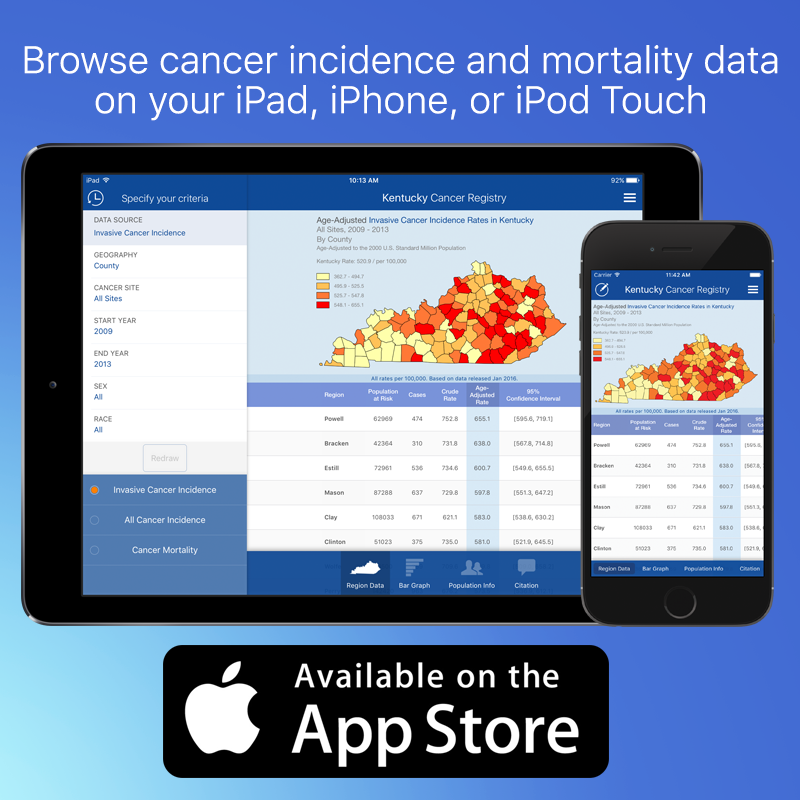History of Cancer Reporting in Kentucky
Kentucky Cancer Registry (KCR) began as a voluntary reporting system in 1986. In April of 1990, the State General Assembly passed legislation that formally established KCR as the population-based central cancer registry for the Commonwealth. The legislation provided recurring funding for staff, travel and computer equipment. Mandatory reporting to KCR officially began January 1, 1991.
All Kentucky acute care hospitals and their associated outpatient facilities are required to report each case of cancer using the Cancer Patient Data Management System (CPDMS) developed by KCR. The larger hospitals (those diagnosing or treating more than 100 new primary cancer cases annually) are required to have their own tumor registrar(s). These larger hospitals are divided into three geographic regions. Three Regional Coordinators are employed by KCR to work with the larger institutions to ensure the quality, accuracy, and timeliness of the data reported. All hospital-based registrars are required to attend extensive formal training programs before they begin abstracting cases. The KCR Regional Coordinators spend one day each month in each of these larger facilities providing additional training, reabstracting cases for quality control and helping the hospital-based registrars prepare reports from the data. The smaller hospitals (those diagnosing or treating fewer than 100 new primary cancer cases annually) are divided into four regions and assigned to one of four Regional Abstractors employed by KCR. The Regional Abstractors record and report information on all cases of cancer seen in these smaller institutions. The KCR Regional Coordinators and Regional Abstractors are required to be Certified Tumor Registrars (CTRs) or become CTRs within two years following their date of employment.
In 1994, the legislation requiring reporting of cancer cases was modified to include reporting from all health care facilities that either diagnose or treat cancer patients. These additional facilities include freestanding treatment centers, non-hospital (private) pathology laboratories, and physician offices (See KRS 214.556). In this same year, KCR received funding from the Centers for Disease Control and Prevention (CDC) through the National Program of Cancer Registries (NPCR). This additional funding allowed KCR to institute a formal quality assurance program, implement complete death clearance follow back, and hire staff to see that all cases of cancer were systematically reported by non-hospital facilities. All of these activities were initiated in 1994. Since 1995, KCR has collected uniform, high quality data on approximately 28,000 new primary cases of cancer occurring in Kentucky residents each year.
In 2000, KCR was selected as one of four expansion registries to become part of the National Cancer Institute's Surveillance Epidemiology and End Results (SEER) program. The SEER registries are considered to be among the most accurate and complete population-based cancer registries in the world. Funding from the SEER program has allowed KCR to further expand its quality control of activities and gather complete follow-up information.
Data from KCR have been submitted to the North American Association of Central Cancer Registries (NAACCR) for an objective evaluation of completeness, accuracy and timeliness each year since a formal certification program was established in 1997. In each year (1999 - 2014) KCR has received the highest level of NAACCR certification available (Gold). KCR has also submitted its data for inclusion in the Cancer in North America (CINA) publication. A registry must have complete data for the most current five-year period before their data can be evaluated for inclusion in the CINA combined rates. KCR data have been included in the CINA combined rates each year since five years of KCR data have been available.
It is not enough to collect complete, accurate, and timely cancer data. These data are of limited value unless they are used to initiate cancer control programs, evaluate intervention activities, or conduct epidemiological research. KCR has worked very hard to ensure that the data collected are both useful and used.
KCR data have been used in preparing hundreds of research projects and proposals. Individual researchers interested in using data from KCR should consult the "Research" section of this web site (when it becomes available) or contact the KCR office.
It is important to note that KCR is part of an integrated cancer control effort of the Markey Cancer Control Program. Data from KCR are presented each year to cancer councils in 15 Area Development Districts (groups of counties) covering the entire state. These District Cancer Councils use the data from KCR to identify specific types of cancer that occur in their area at substantially different rates compared to state and U.S. rates.
The data are presented as maps and focus on cancers for which there are scientifically proven cancer control interventions. This process has allowed sub-geographic areas of the state to identify cancer control issues that could not have been seen without a population-based cancer registry and to target their limited resources. The process has resulted in the implementation of many cancer control interventions intended to reduce identified cancer control problems and KCR data continue to be used to monitor the impact of these interventions.
